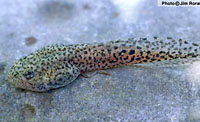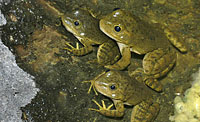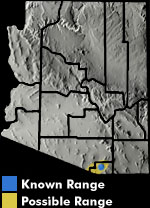Online Field Guide to The Reptiles and Amphibians of Arizona


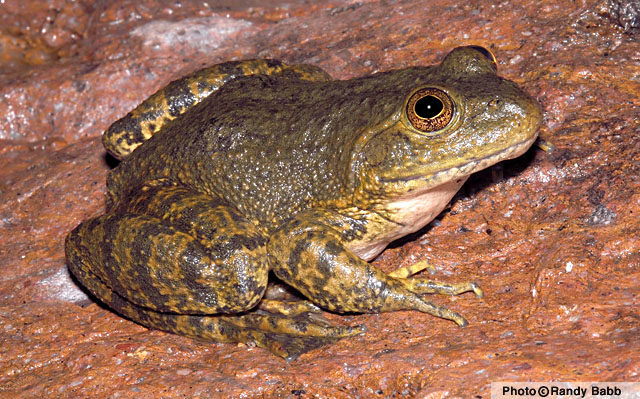
Southern Arizona
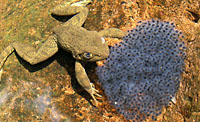 With egg mass. Southern AZ |
| TARAHUMARA FROG Lithobates tarahumarae | |
|
DESCRIPTION: Up to 4.5 inches in length, this is usually a brown frog that may have an olive green wash or tinges of yellow-orange. The back has dark spots that are often obscure, and the hind legs exhibit prominent dark banding. Dorsolateral folds are usually absent or very weak and the tympanum is indistinct. The Tarahumara frog is most easily confused with the American bullfrog, which grows to a much larger size, has a conspicuous tympanum, smoother skin, and a chin that is white with gray mottling. Large Tarahumara frog tadpoles grow to 4 inches and have large dark spots that may merge to form a reticulation. DISTRIBUTION: The historical range of the Tarahumara frog in Arizona included a few canyons in the Pajarito, Tumacacori, and Santa Rita mountains. The Tarahumara frog apparently disappeared from all of its Arizona localities by May 1983. On June 26, 2004, the first of several releases of Tarahumara frogs to one of its historical localities in the Santa Rita Mountains was carried out by the Tarahumara Frog Conservation Team. Frogs for this experimental re-establishment project were obtained from the Sierra de la Madera in northern Sonora. HABITAT: This frog is a habitat specialist of rugged canyons with deep plunge pools and tinajas. Vegetation in these canyons is characterized by a riparian community within oak and pine-oak woodlands. BEHAVIOR: The species is predominantly nocturnal, but can also be found abroad during the day, particularly juveniles. This is probably the most aquatic of Arizona’s ranid frogs, and is rarely found more than a few hops from water. DIET: Documented prey items include a variety of invertebrate and vertebrate prey, such as beetles, hornets, water bugs, hatchling mud turtles, and small snakes. REPRODUCTION AND CALLS: This frog breeds primarily in April and May, but occasionally in late summer, as well. Up to 1800 eggs are laid in a spherical mass that lay on the bottom of ponds in shallow water. Tadpoles may take as long as 2 years to metamorphose, but in captivity can metamorphose in <90 days. Despite an absence of vocal sacs, Tarahumara frogs manage a variety of sounds, including a gentle snore, a whine, an eep, a short squawk, and a release or distress call composed of a series of short snores. REMARKS: Suspected causes of decline and disappearance in the 1970s and 80s include chytridiomycosis (a fungal disease), introduced predators in the Peña Blanca area, possibly airborne emissions from copper smelters, flooding, and winter cold. During the summer of 2006, heavy rains eroded hillsides damaged by a catastrophic fire in the upper watershed of the canyon where this frog was recently reestablished. Large amounts of cobbles and gravel washed into the plunge pools used by this species. As a result, the pools are less drought-resistant, and this wild population of Tarahumara frogs – the only such population in the United States – could be eliminated during extended drought. PROTECTED Hale, S.F., C.R. Schwalbe, J.L. Jarchow, C.J. May, C.H. Lowe, and T.B. Johnson. 1995. Disappearance of the Tarahumara frog. Pages 138-140 in LaRoe, E.T., G.S. Farris, C.E. Puckett, P.D. Doran, and M.J. Mac (eds.), Our Living Resources: A Report to the Nation on the Distribution, Abundance, and Health of U.S. Plants, Animals, and Ecosystems. U.S. Department of the Interior, National Biological Service, Washington, D.C. Rorabaugh, J.C., and L. Elliott. 2006. Calls of the Tarahumara frog. Sonoran Herpetologist 19(12):134-136. Rorabaugh, J.C., and S.F. Hale. 2005. Rana tarahumarae Boulenger, 1917, Tarahumara frog. Pages 593-595 in M.J. Lannoo (ed), Amphibian Declines: The Conservation Status of United States Species. University of California Press, Berkeley. |
|
Visit Partners in Amphibian and Reptile Conservation:


HOME
Copyright © 2023, Arizona Game and Fish Department. All rights reserved.
If you make use of the textual contents of this site in reports, publications, etc. please cite and credit the author(s) and photographer(s). All photos on this website are copyrighted. However, those found in the species account section may be used for any noncommercial scientific, educational, or conservation purposes provided that photographs are not altered and continue to bear the copyright symbol and name of the photographer. Please contact the photographer regarding commercial use of copyrighted photographs.










